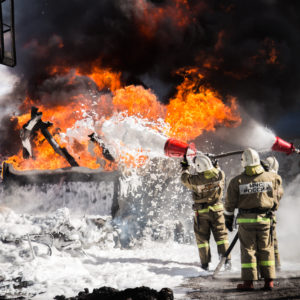Firefighting Foam Chemicals Exposed Firefighters to Cancer Risk For Decades

For decades, military and civilian firefighters have used aqueous film-forming foams (AFFFs) during training exercises and in response to fuel-based fires, which contained toxic chemicals that exposed multiple generations of firefighters to a risk of cancer.
Certain versions of firefighting foam that have been widely used since the mid-1960s contained per- and poly-fluoroalkyl substances (PFAS), due to the ability of the chemicals to resist heat, grease, stains and water. However, studies done as early as the late 1960s indicated the chemicals may have toxic side effects, impacting the liver, testicles and other organs.
PFAS chemicals have been linked to a myriad of adverse health effects including liver damage, thyroid disease, decreased fertility, high cholesterol, obesity, hormone suppression, and cancer.

Learn More About
Exposure to firefighting foam chemicals may result in an increased risk of cancer for firefighters, military and airport personnel.
Learn More About this Lawsuit SEE IF YOU QUALIFY FOR COMPENSATIONBy the end of the 1970s, industry testing found some PFAS chemicals bind to proteins in the blood. Additional testing in the 1980s found PFAS were linked to testicular tumors, and DuPont, internally, determined PFAS as an animal carcinogen, and possibly human carcinogen. However, neither firefighters nor those living in areas where AFFFs were heavily used were warned about the risks associated with exposure.
Additional studies over the past few decades have increasingly pointed to a link between PFAS and cancer, until 2010, when 3M Comany and DuPont linked the chemicals to health impacts on workers exposed to the chemicals.
The chemicals are projected to take thousands of years to degrade, and past studies have shown their ability to enter and stay in the environment and human body through the air, dust, food, soil, and water. Previous U.S. Centers for Disease Control and Prevention (CDC) studies have shown PFAS chemicals primarily settle into the blood, kidney and liver, and could likely be detected in the blood of 98% of the U.S. population.
In June 2019, a federal investigation found that PFAS chemicals are commonly found in numerous food products, including meats, seafood, chocolate, cake and other products. However, the FDA released a statement indicating that the levels found do not raise health concerns, based on the best available science.
According to findings published in the Journal of the American Medical Association in 2012, exposure may also suppress the immune system and limit the ability of the body to create antibodies in response to childhood vaccines.
By December 2018, a panel of federal judges indicated that a growing number of firefighting foam lawsuits filed in federal courts nationwide should be centralized in the U.S. District Court for the District of South Carolina for pretrial proceedings.
As firefighting foam lawyers continue to review and file claims for former fire fighters diagnosed with cancer, the size and scope of the litigation is expected to involve several hundred claims brought in courts nationwide over the coming months and years.
Get more articles like this sent directly to your inbox.
"*" indicates required fields






0 Comments